Adding plants to a betta’s home is one of the best things any hobbyist can do. Plants make the tank look nicer, improve the health of the tank, and enrich bettas.
Bettas live in rice paddies in Southern Asia. Most new hobbyists believe rice paddies are small and that bettas can live in small spaces. Yet, rice paddies span large distances and host many native plants. Bettas like plenty of room to explore; the plants help them do that.
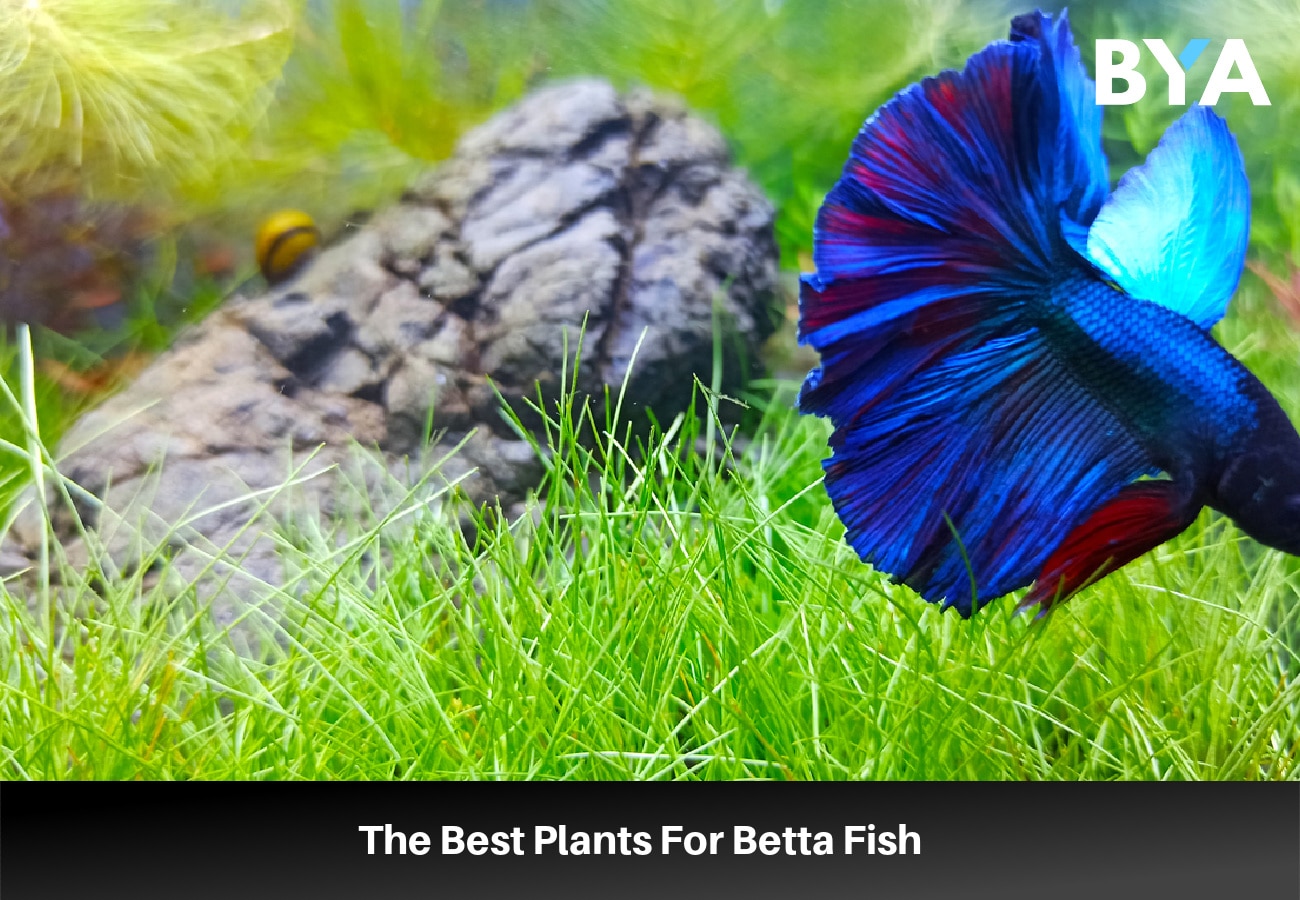
Bettas also love to rest; they’ll find a broad-leafed plant and take a “nap.”
Most betta owners are new to the aquarium hobby and may not know where to start on plants. Fortunately, some of the easiest plants to care for are best suited for bettas.
What Are The Benefits Of Keeping Live Plants?
One of the main benefits of keeping live plants is the visual aspect. They make the tank look nicer and give them a natural feel.
Experienced Aquarists often learn to create stunning tank setups using plants. There is even a word for it: aquascaping.
Bettas Use The Plants To Explore & Rest
Live plants are the perfect decoration for bettas. Bettas don’t bother plants like some fish, and they love having places to hide.
Vegetation is common in the wild spaces that bettas inhabit. They are familiar with having lots of plants in their swimming space. Betta owners can replicate their natural environment and encourage natural behaviors with plants.
Bettas love to rest on the leaves of plants. Owners should offer them a selection of plants with large, broad leaves.
New owners are often alarmed when they see their betta lying on a leaf. They rest on their sides and become pretty still for a time — it looks like they are ill. Yet, this behavior is normal and equal to a betta taking a nap.
Filtration & Aeration
Another bonus of keeping live plants is that they make the tank healthier. Plants filter the water, absorbing harmful toxins and using them to grow. They aren’t enough to replace a filter, though they greatly help.
Since they use the nutrients in the water to grow, plants reduce the number of nutrients in the water. The fewer nutrients in the tank, the less hobbyists struggle with algal growth.
Plants even remove carbon dioxide from the water and replace it with oxygen. Sometimes, hobbyists can avoid buying bubblers by having lots of plants.
Are There Disadvantages To Keeping Live Plants?
For most, the benefits of live plants far outweigh the disadvantages. Still, there are some disadvantages to keep in mind.
Live plants need more maintenance than fake plants. Hobbyists must have the proper lighting, nutrients, and water conditions. Fast-growing plants need trimming every few weeks.
The pants on this list are relatively easy to care for and don’t need special care.
Some of the most challenging aquarium plants need special fertilizers and additives. Others need expensive CO2 systems.
Floating plants are great; be careful not to let them cover the entire surface of the water. Bettas need to breathe air to survive; they must be able to access the water’s surface periodically. Too many plants at the surface have the potential to suffocate a betta.
22 Best Betta Fish Plants: Our Top Picks
Here are 22 of the best live plants for betta fish tanks:
1. Amazon Sword
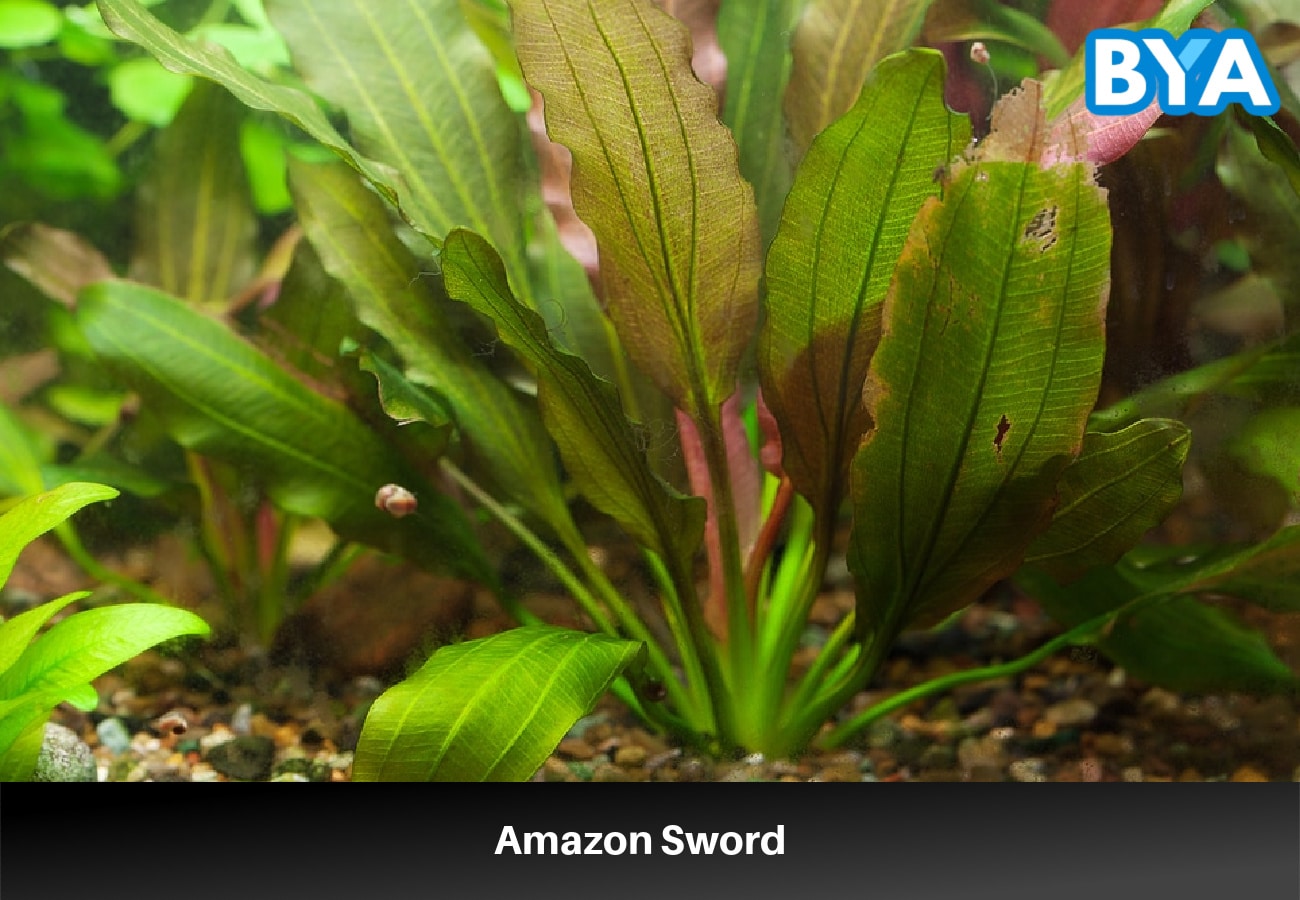
- Lighting: High
- Difficulty: Easy to Moderate
These tall plants stand vertically in the tank. Their broad leaves make them aesthetically pleasing. They can also fill a lot of space in any aquarium.
Amazon swords are one of the biggest plants on this list. They can grow up to 3 ft (1 m) tall.
Due to their large size, these plants are better for ten gallons or larger tanks.
Sometimes, filters or gravel vacuums rip them from the substrate because of their size. Aquarists will need a few inches of a substrate to bury the roots in to prevent uprooting.
Unfortunately, Amazon swords aren’t the easiest plants to care for because they need a lot of light.
2. Anubias Nana
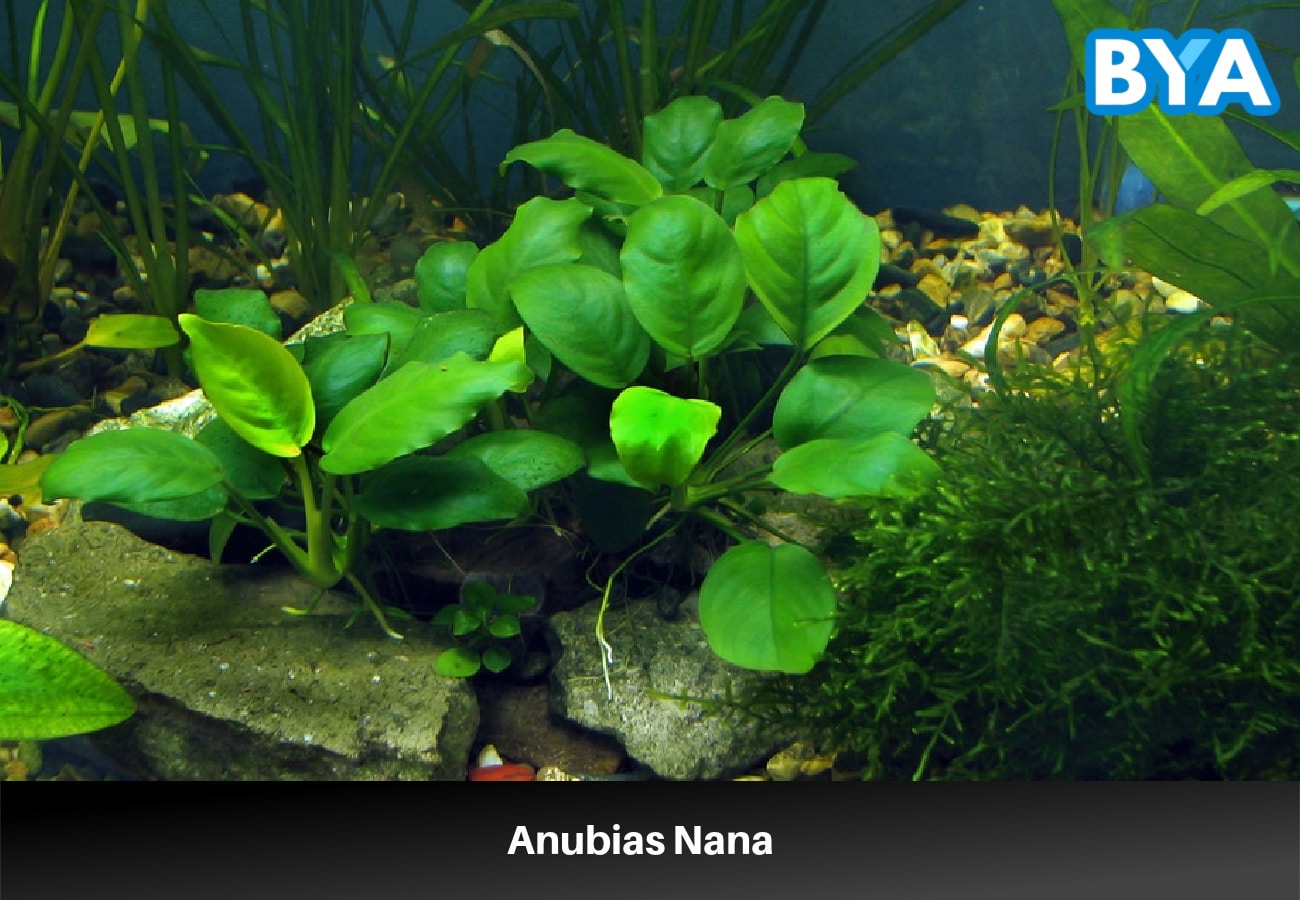
- Lighting: Low to high
- Difficulty: Easy
The Anubias nana is one of the best plants for a betta tank because of its broad leaves.
Unlike the Amazon sword, which stands vertically, Anubius nana leaves hang horizontally. Their leaves are perfect resting spots for tired bettas.
These plants are small; they don’t take up a lot of space, making them ideal for smaller betta homes. Slow growers, they stay a good size for smaller tanks and make cleaning the tank easier.
They don’t need much light or fertilizer and are simple to care for.
Anubias nana leaves are bitter. Snails and other plant-eating organisms are unlikely to eat them.
Aquarists can get creative with these plants. They can bury them in the substrate or attach them to rocks and driftwood with aquarium-safe glue.
Pet stores also supply Easy Planter decorations that can hold the Anubius.
Many times, Anubius comes planted inside a pot. Hobbyists can leave the plant inside the pot and stick the pot inside the planter.
Usually, these planters look like rocks. They make it easy to create a natural look inside the aquarium.
3. Marimo Moss Balls
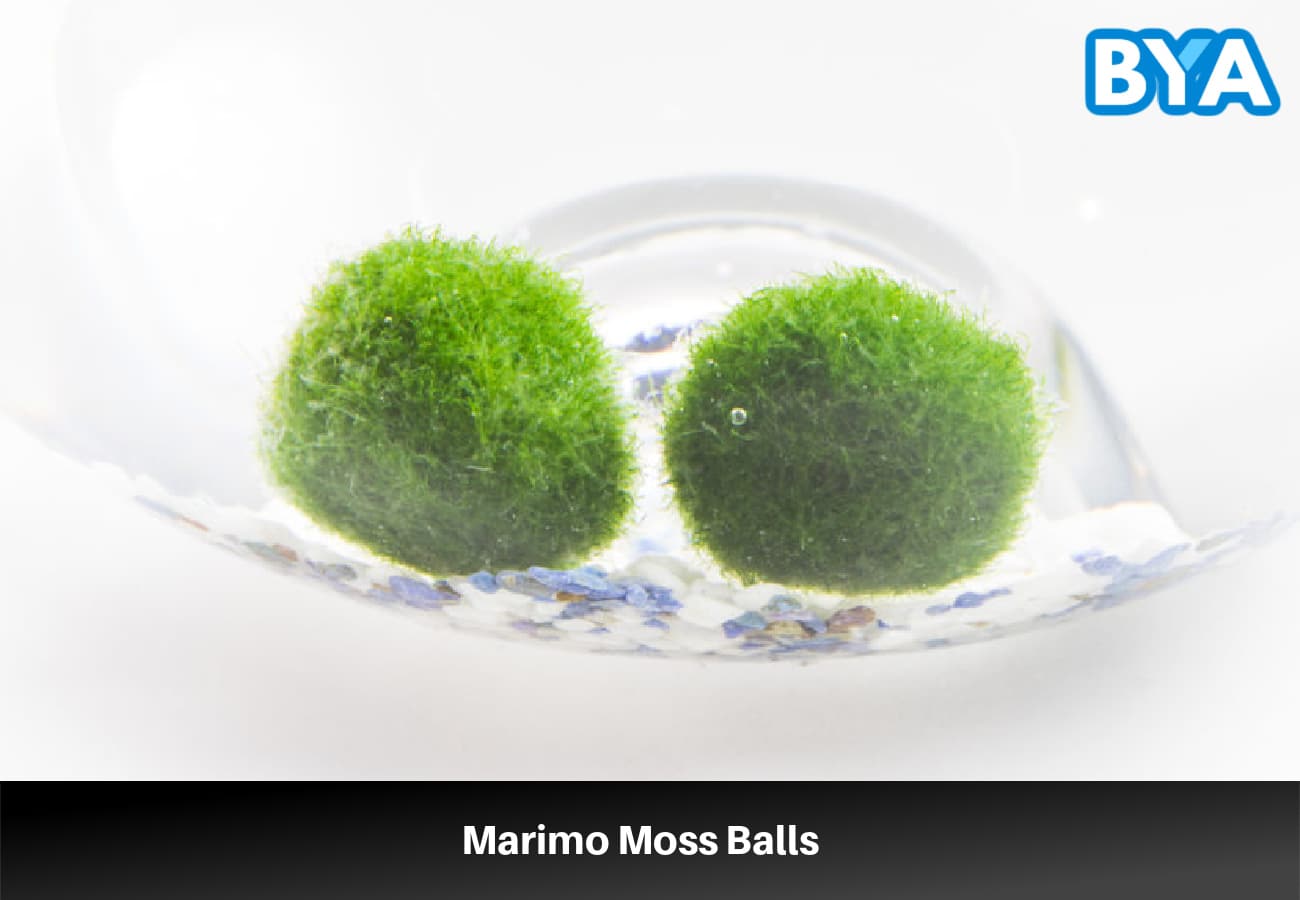
- Lighting: Low & Indirect
- Difficulty: Moderate
Moss balls are one of the most popular options for any aquarium — they are cute, grow large, and are easy to care for.
Marimo moss balls are algae, though they won’t spread throughout the tank like nuisance algae.
In the wild, they exist in the slow currents of Japanese and Northern European lake beds. These gentle currents shape the moss into balls.
Keep marimo moss balls in indirect light, as they start to turn brown and die when in direct light. A moss ball that has only begun to turn brown isn’t dead yet. Move it to a cooler and shadier location in the tank.
They aren’t fond of warm water and do better in cool waters. Moss balls can still do well in a betta’s tropical waters, though they won’t grow as large.
Moss balls also have the annoying tendency to float. Air bubbles get trapped inside them when they are removed from water. Gently squeeze the moss ball to remove the air bubble, and it will sink in one to two days.
Unfortunately, moss balls need some extra care to thrive, though bettas seem to enjoy them.
The balls are large and soft, making them ideal resting spots for bettas. Some bettas will even play with them, rolling them around the tank.
They do best in temperatures below 75°F (23.9°C) and need pristine water quality. The water shouldn’t have extra nutrients, and they prefer low, indirect lighting.
Marimo moss balls living in unideal situations rarely die. They typically stay the same size and don’t grow.
Low-current tanks — like betta tanks — may cause the moss ball to flatten out over time. A flattened moss ball is not dying; it is still beneficial — it simply loses its unique shape.
4. Java Fern
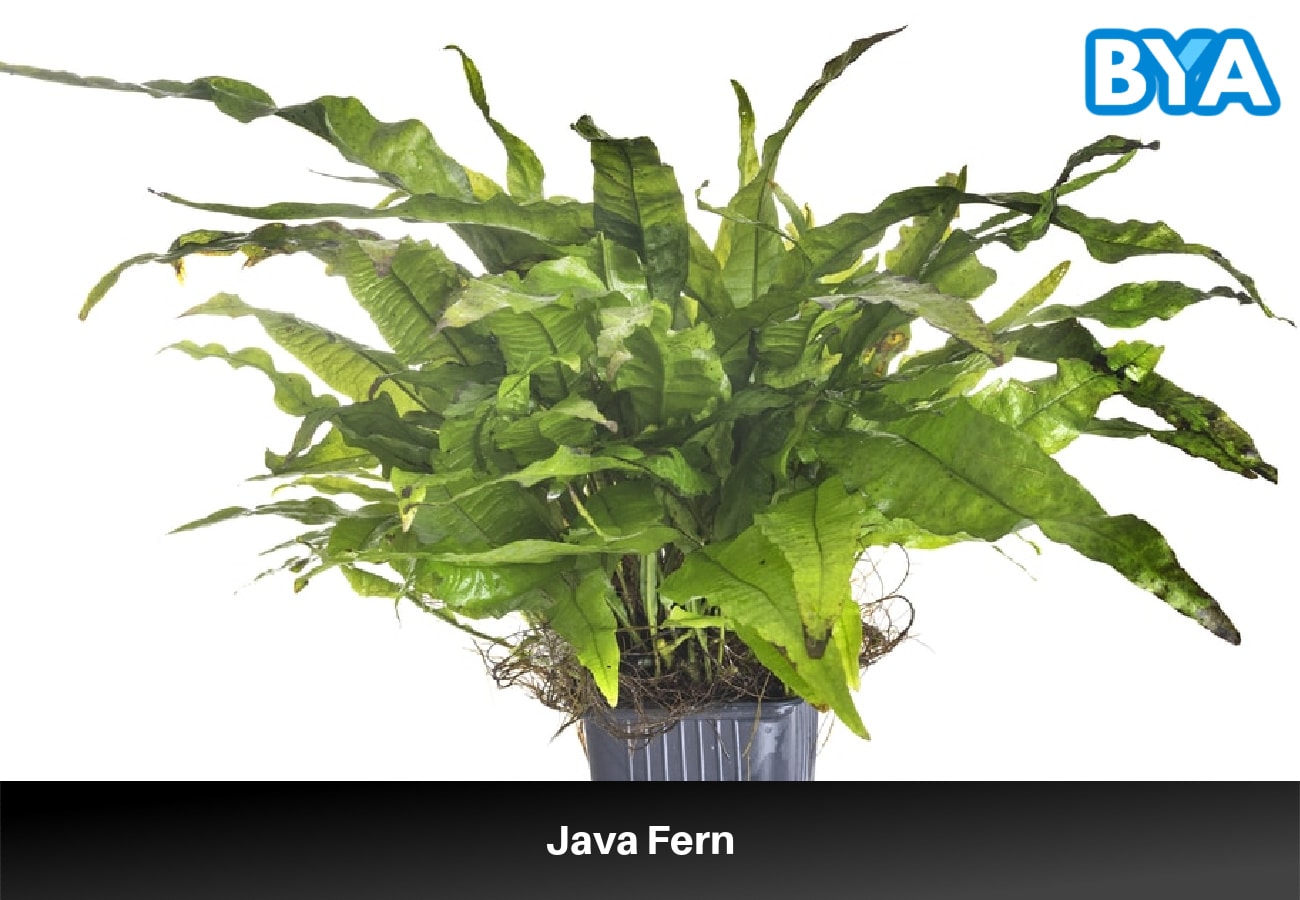
- Lighting: Low to Moderate
- Difficulty: Easy
These plants are one of the best for beginning aquarists as they are extremely easy to care for. They only need minimal lighting and grow slowly. They won’t overtake a tank and don’t need trimmings very often.
Java ferns have long, thick leaves.
Like Anubias barteri, these plants have rhizomes that aquarists cannot bury. Use aquarium-safe glue or rubber bands to attach these plants to rocks or driftwood.
Most aquarists use rubber bands because they can remove them after some time.
Eventually, the roots will grow and bury themselves in the substrate. Or, they may wrap themselves around the rock or driftwood they are sitting on.
The roots create a natural anchor despite the rhizome not being secure. Once the roots have attached themselves, hobbyists can cut the rubber band off.
Java fern is a good investment because it produces baby plants along the mature leaves. Aquarists can pick off the baby plants and plant them elsewhere around the tank or put them in another tank.
5. Water Sprite
![]()
- Water Sprite (source)
- Lighting: Moderate to High
- Difficulty: Easy to Moderate
Water sprites are a type of fern that bettas particularly seem to enjoy. Betta hobbyists sometimes call these plants a “betta fish playground.” The fish spend much time hanging out in their leaves.
These are great for betta tanks because aquarists don’t have to plant them. They can simply float at the top of the tank for the betta to play in.
They do well buried in the substrate, too.
Plants floating at the top of the tank can encourage male bettas to make bubble nests. Bubble nests aren’t necessary for the happiness of a betta. Still, some hobbyists enjoy seeing the behavior or are trying to breed their betta.
Be conscious of the plant’s growth if left floating at the top of the tank. They cover much surface area and may prevent plants at the bottom of the tank from getting any light.
These plants thrive in high light. They won’t die in low light, though they grow better with more of it.
In high light, they grow rapidly and need frequent trimming.
6. Java moss
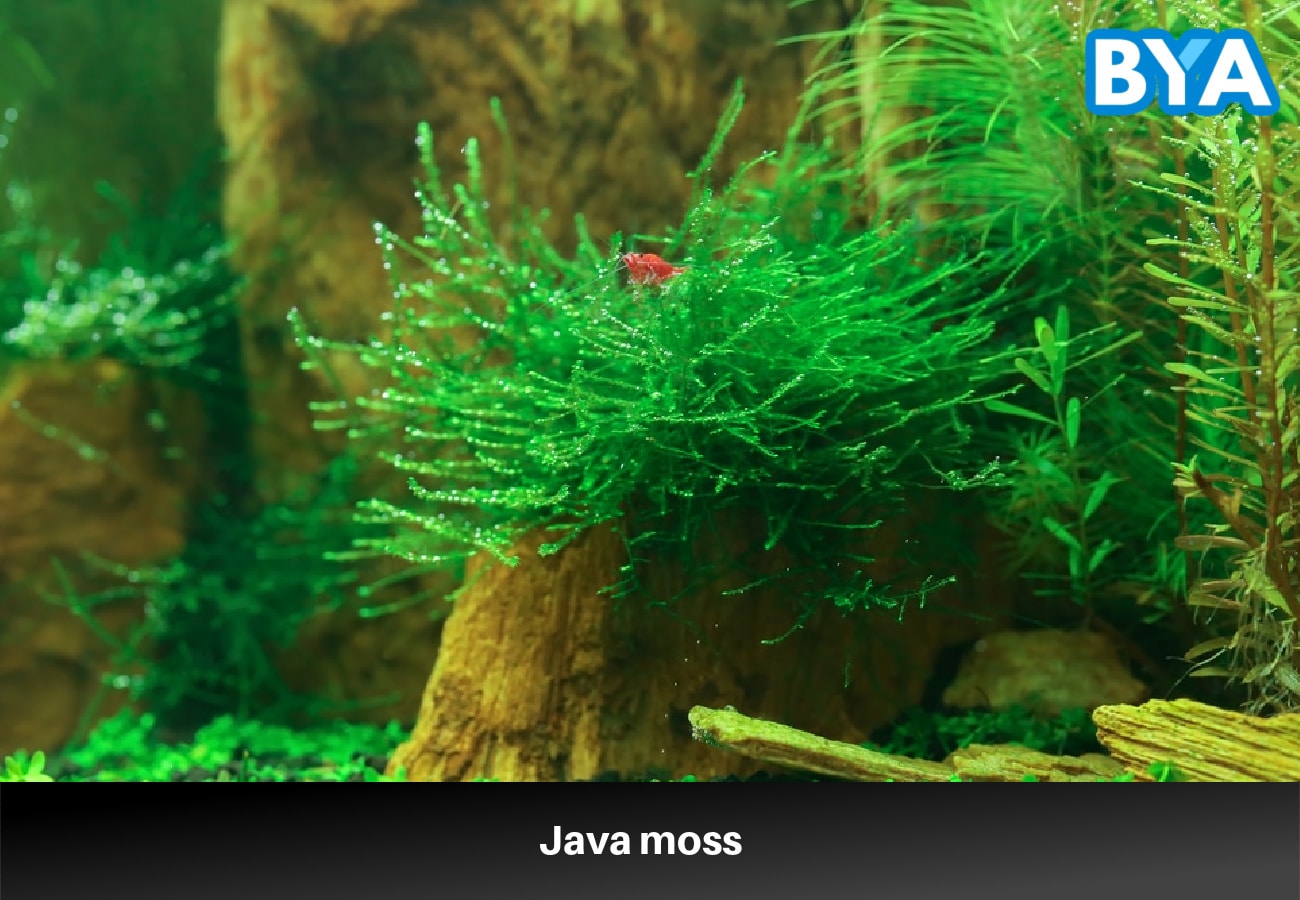
- Lighting: Low to Moderate
- Difficulty: Easy
Java moss is popular amongst aquarists. It’s effortless to care for, looks nice, and offers many benefits.
Due to how thick it grows, bettas love to hide in and explore java moss.
Java moss can tolerate almost any water conditions and thrives in low light. It doesn’t need to attach to the substrate or decorations — it can float around the tank.
Still, some hobbyists enjoy attaching it to driftwood to create a natural look. Others use it to make a carpet along their substrate.
Java moss multiplies and spreads everywhere across the tank. Maintaining it can be frustrating, though most think it’s worth it.
7. Anacharis
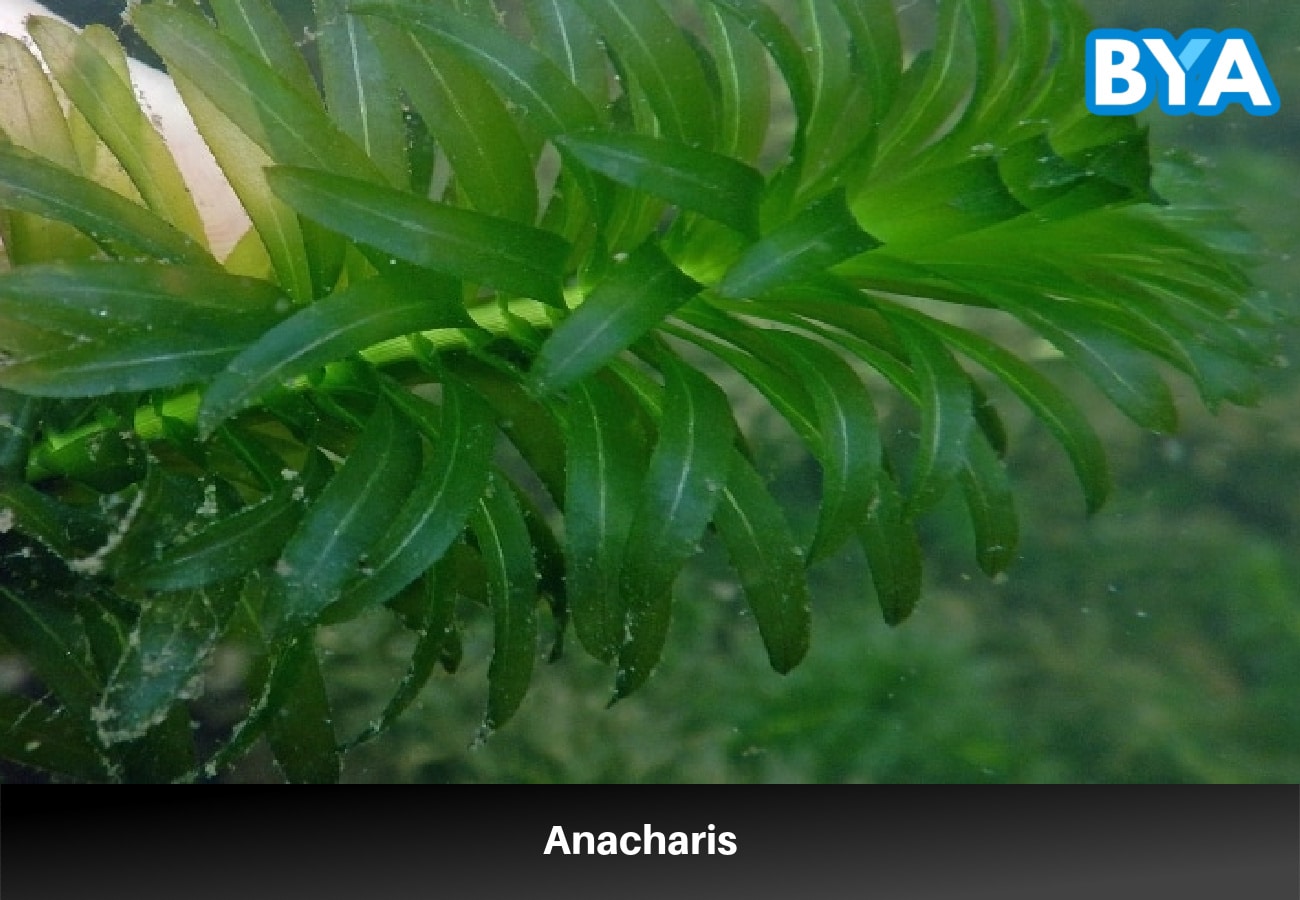
- Anacharis (source)
- Lighting: Moderate to High
- Difficulty: Easy
These plants are another favorite among aquarists and bettas. The large, broad leaves are perfect for bettas to rest on. They create shade for the betta to hide in if they want a break from direct light.
Anacharis grows thickly. Planting several together creates a forest-like effect for the betta to explore.
Anacharis is beneficial for the water. It’s great at filtering toxins and absorbing nutrients in the water to slow down algae growth.
The leaves are bright green and aesthetically pleasing for any tank.
Aquarists have lots of options for decorating their tank with anacharis. They can root it in the substrate, attach it to rocks or driftwood, or leave it floating.
Anacharis is a bit trickier to care for because it needs bright light. Without enough light, the lower leaves begin to drop. The dying leaves can cause an ammonia spike, and leave the plant ugly.
8. Pennywort
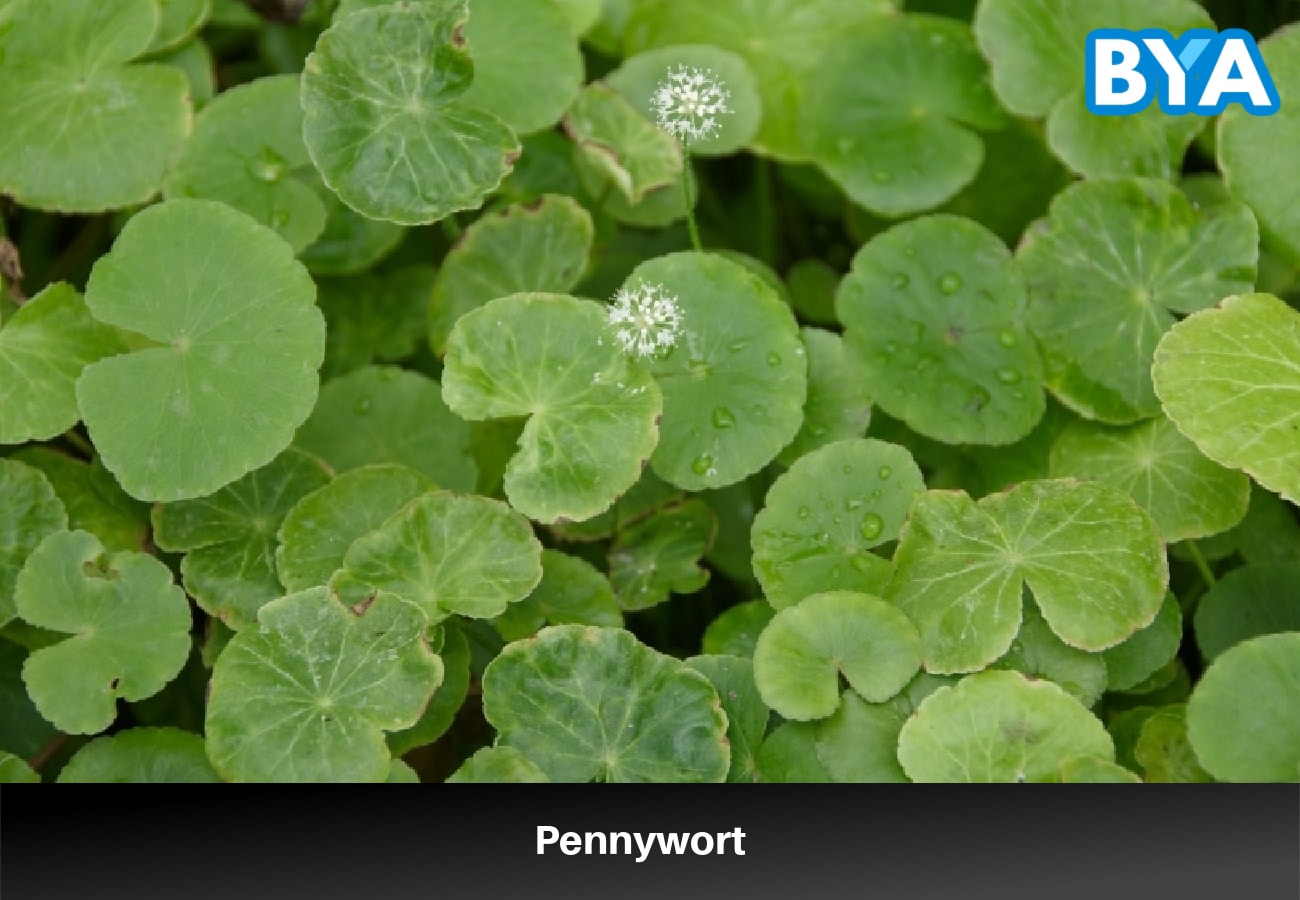
- Pennywort (source)
- Lighting: Moderate to High
- Difficulty: Easy
These plants are one of the easiest to care for. They thrive in high-light conditions and can live wholly submerged or with the top out of water.
Pennywort loves light. It grows vertically toward the light and can grow as much as 1 in (2.54 cm) in a week.
Since it grows fast, aquarists must trim it regularly. Trimming prevents it from covering the water’s surface.
9. Duckweed
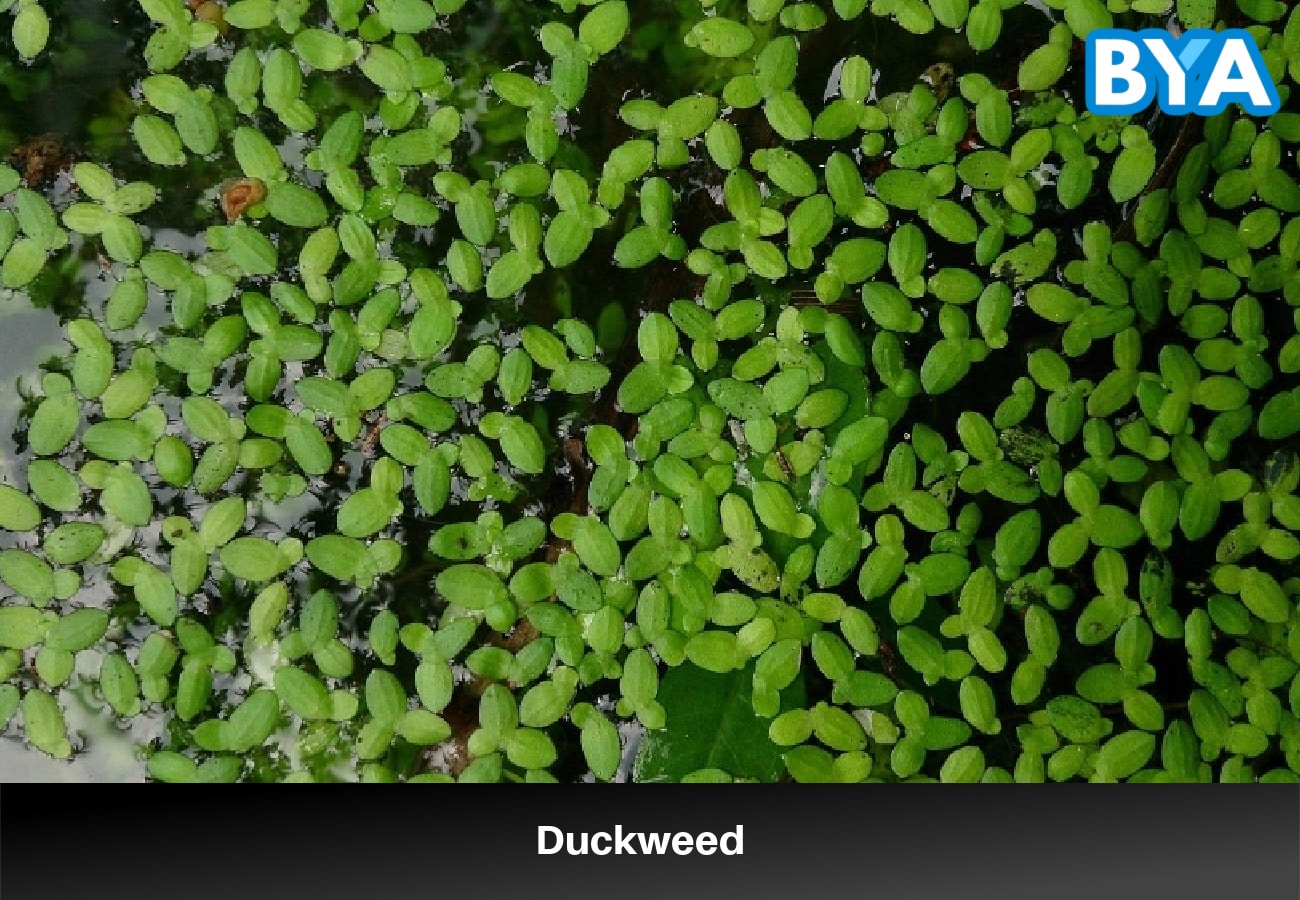
- Duckweed (source)
- Lighting: Low To High
- Difficulty: Easy
Some aquarists love duckweed, while others hate it. It provides a unique, swamp-like appearance. It is difficult to replicate that appearance with other plants.
Yet, duckweed grows rapidly and can be challenging to remove once it’s entered a tank. Removing the leaves from the tank can be difficult. They are tiny and easily pushed around by the currents.
A single plant can reproduce in a few days, creating many new plants.
Since it grows fast, duckweed can cover the surface. It may block light from plants growing underneath.
Hobbyists constantly remove duckweed from the tank because of how quickly it grows. For some, the growth is too annoying to deal with.
Many aquarists buy floating plastic rings that they place the duckweed inside. Using these allows for the swamp-like aesthetic while preventing overgrowth.
Be cautious with duckweed. It is illegal to own in some places because it’s considered invasive.
10. Hygrophila
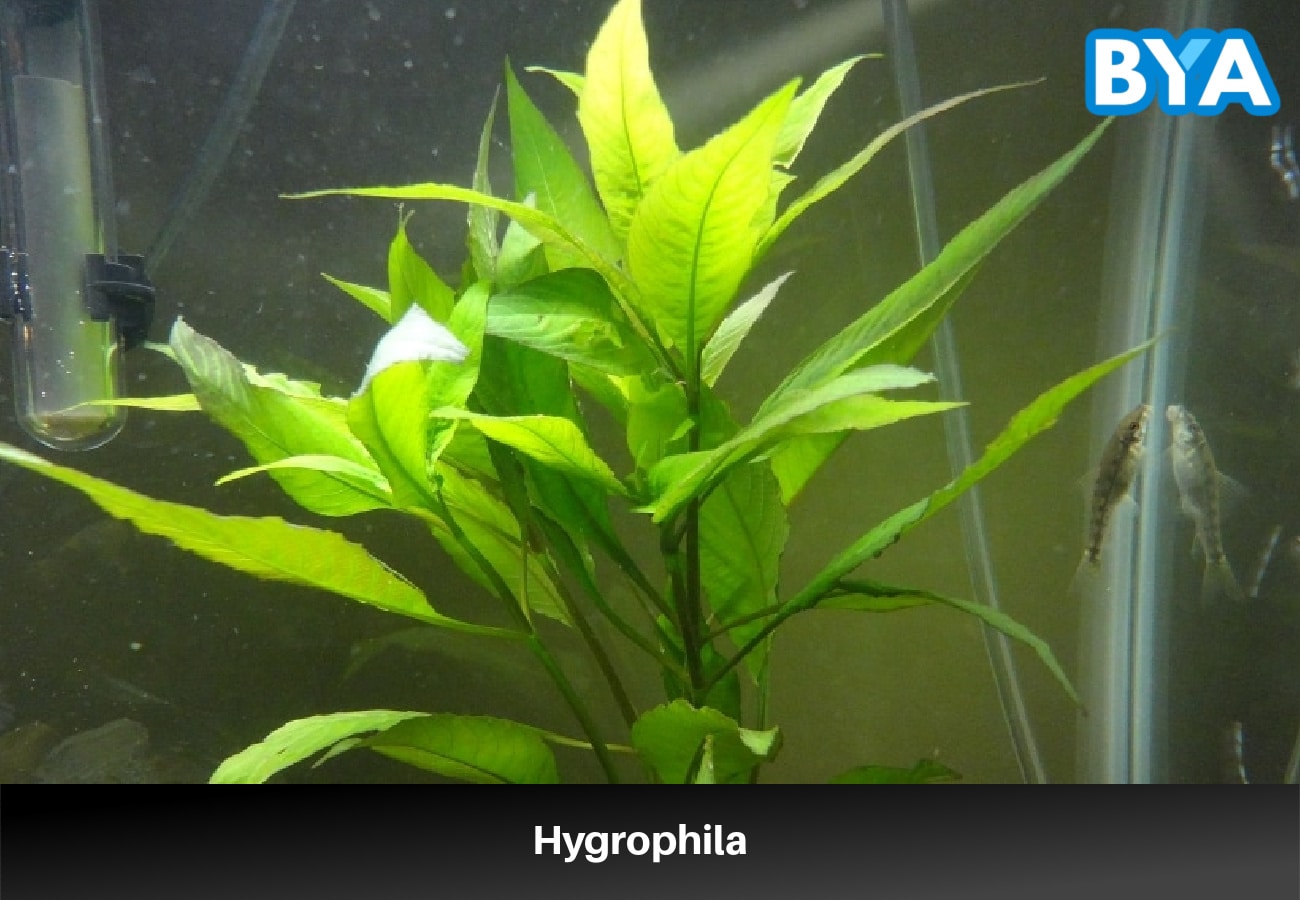
- Hygrophila (source)
- Size: Up to 28 in (71.1 cm)
- Lighting: Moderate to High
- Difficulty: Moderate
These plants are another favorite among bettas. They have large, broad leaves for resting.
Hygrophila grows very tall; it’s best for tanks of at least 20 gallons. Many aquarists keep these in community tanks with a betta as an inhabitant.
These plants need moderate light. They will drop their lower leaves if the lighting is insufficient.
11. Hornwort
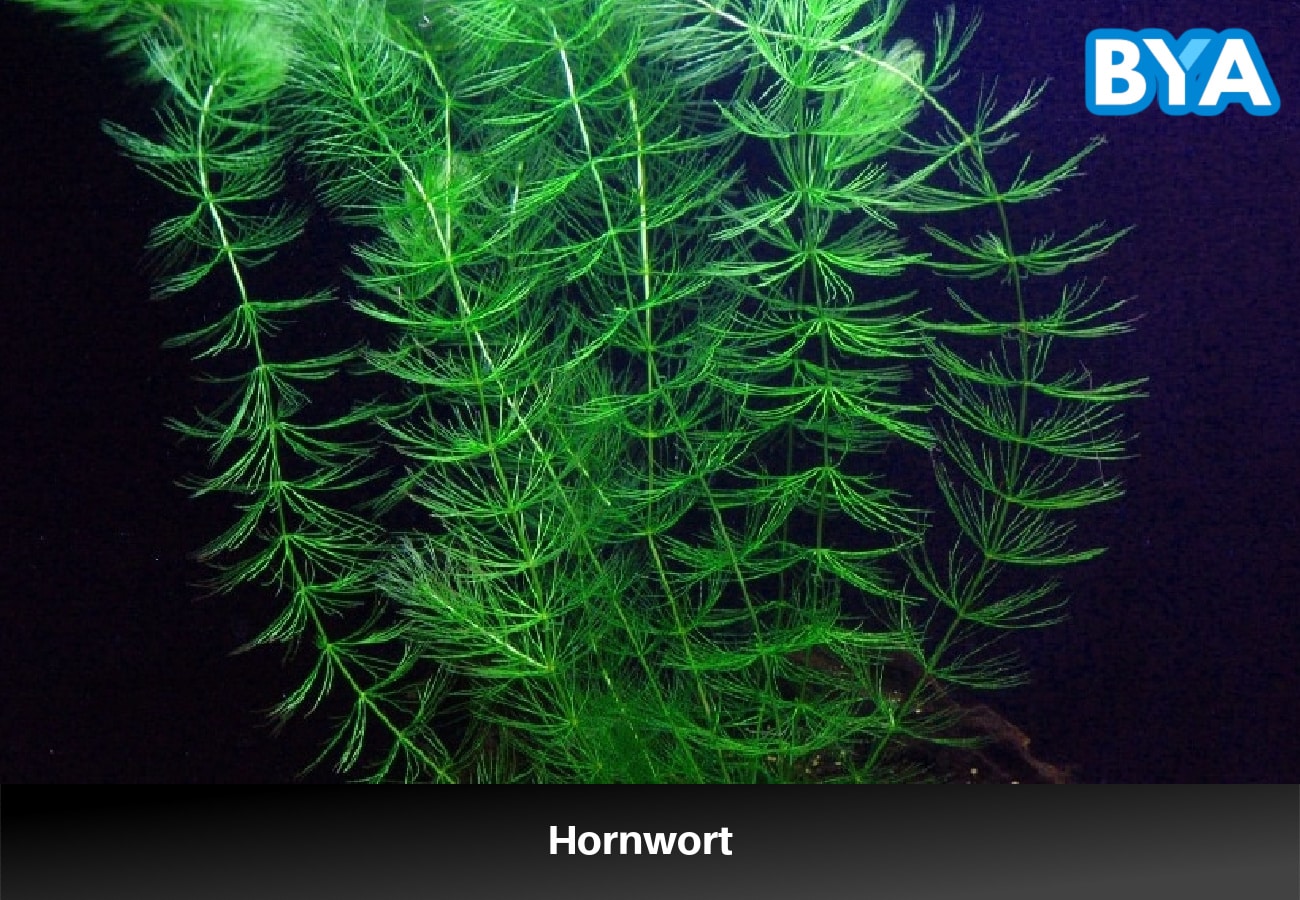
- Hornwort (source)
- Lighting: Low to High
- Difficulty: Easy
Hornwort is one of the most popular plants for betta tanks because of its ease of care and thickness.
Aquarists can plant hornwort in the substrate. Planting several together creates a thick, forest-like effect.
The plant also does well floating at the top of the tank.
These plants are great for the health of the tank. They remove nitrates and other toxins.
Hornwort is incredibly hardy and can tolerate a wide range of water conditions. They are one of the most difficult plants to kill.
Hornwort does not need a lot of light and grows rapidly. It needs frequent trimmings — be gentle, as the plant is delicate.
12. Wisteria
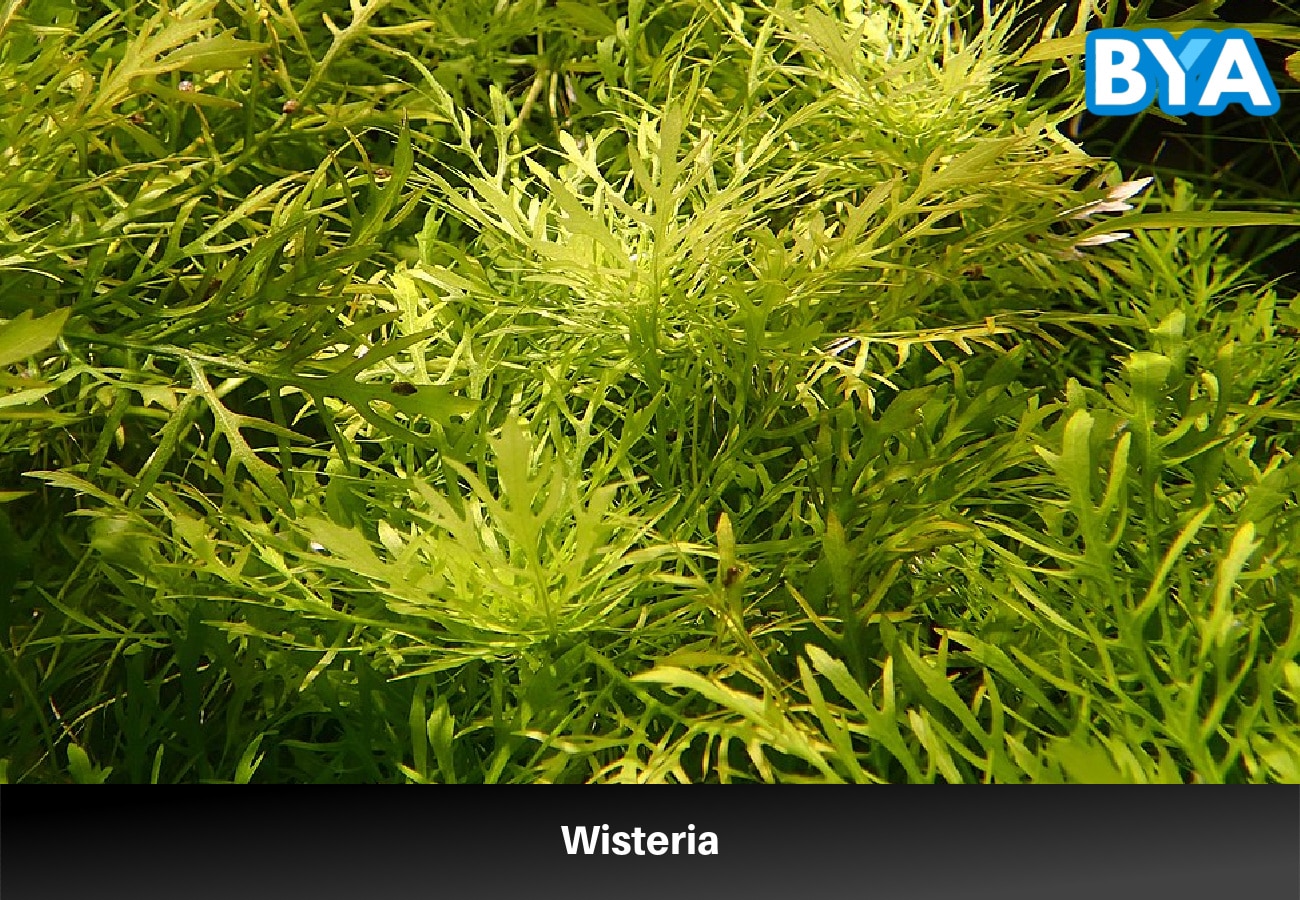
- Krzysztof Ziarnek, Kenraiz / CC BY-SA
- Lighting: Moderate
- Difficulty: Easy
Wisteria is another super easy plant to care for because it does well in low-light conditions.
The thickness of the leaves can create a forest-like effect.
Wisteria plants should be robust when the hobbyist buys them, or they won’t last long in an aquarium. They grow tall quickly — meaning the stem should be strong enough to hold itself upright. Look for plants that are standing tall, and avoid ones that are drooping.
Choose wisteria with long roots that will keep the plant firmly rooted in the ground. Without long roots, the long stem and heavy leaves will drag the plant down. Short roots also make it easier for fish to tear up the plants.
Lastly, pick plants that are lush and green — avoid plants whose leaves have yellow or brown spots.
Hornwort and wisteria look similar. Yet, wisteria leaves have a unique shape that separates them from hornwort.
For thicker coverage, aquarists should plant the whole, tall plant. Wisteria can grow to over 1 ft (0.3 m) tall.
Hobbyists can cut the plant into smaller pieces and use it as carpet along the substrate. The cut plant quickly begins growing new roots that attach to the substrate.
Wisteria is best for tanks with at least ten gallons since it grows fast. It needs a lot of trimming and easily overtakes smaller aquariums.
13. Amazon Frogbit
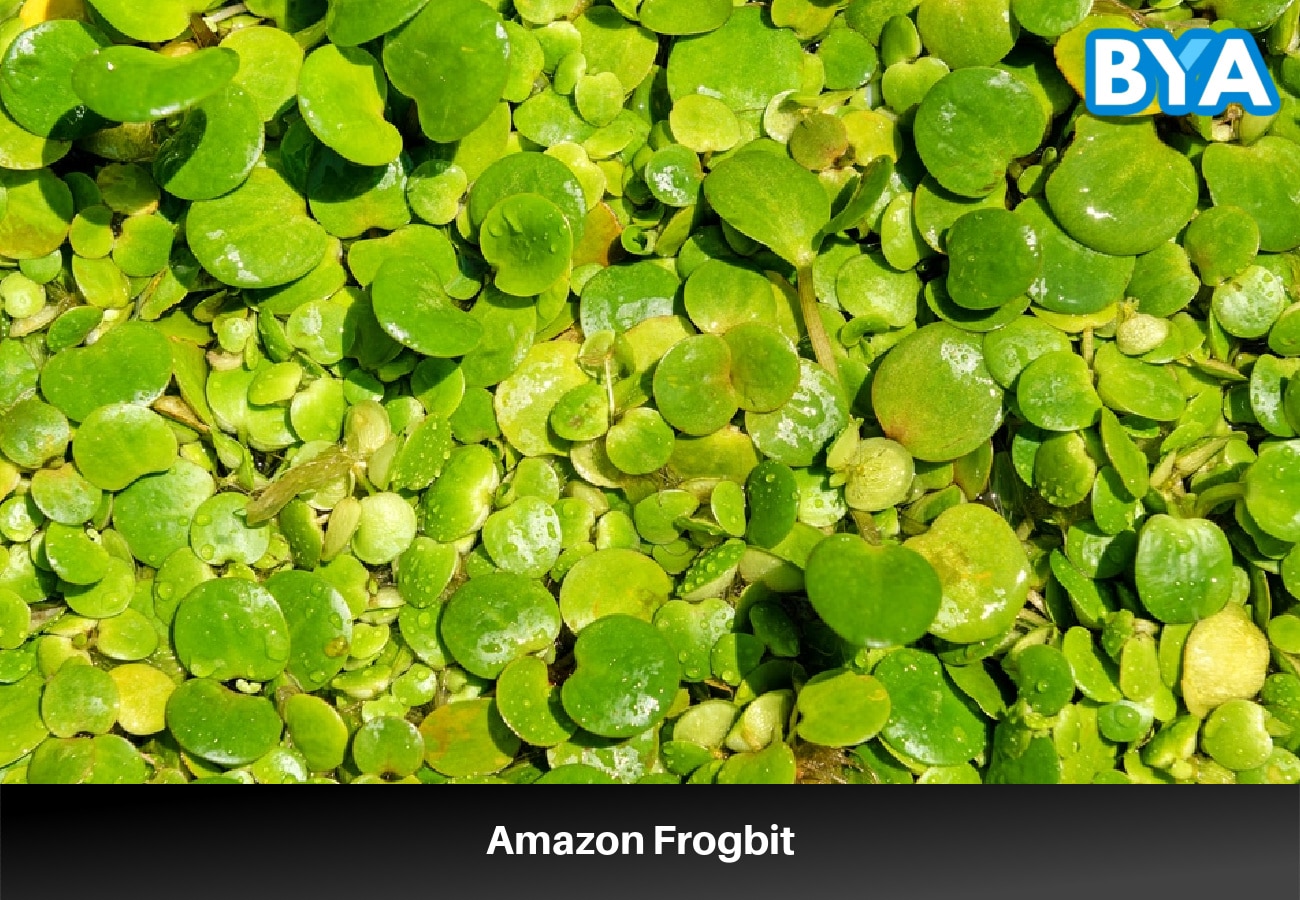
- Lighting: Low to High
- Difficulty: Easy
Amazon frogbit looks like duckweed. It grows larger, making it easier to maintain. The roots are also larger, giving the betta a place to explore.
These plants still have the potential to cover the surface of the water like duckweed. Coverage takes much longer, though. Aquarists need to get rid of some of the extra plants periodically.
14. Anubias Barteri
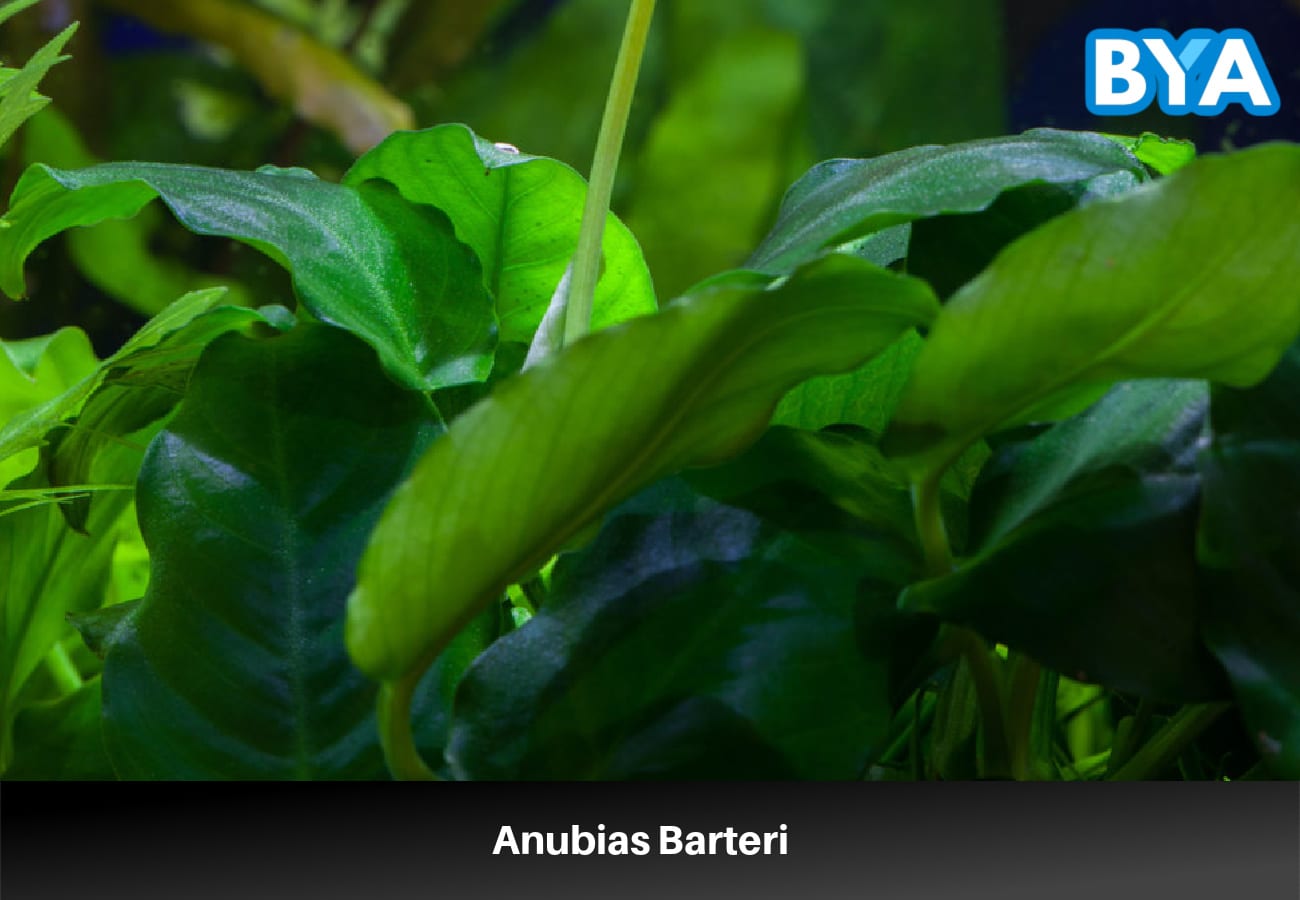
- Size: 18-24 in (45.7-61 cm)
- Lighting: Low to High
- Difficulty: Easy
These plants are incredibly hardy, making them one of the easiest to care for. They thrive in low-light conditions and are slow growers.
They are safe from most snails and fish because the leaves taste bad.
Sometimes, algae will grow on the leaves; aquarists can gently scrub the leaves to get rid of the algae.
Anubias nana is one of bettas’ favorite plants. Their large leaves are ideal for resting. The good news is that they are also simple to propagate, which can save hobbyists lots of money.
These plants have a rhizome that grows parallel along the ground and bears new plants. Snip off a part of the rhizome with leaves and stems and replant it. A brand new plant will begin growing.
They do not have typical roots — they have rhizomes. Rhizomes are stems that grow horizontally underground. Shoots and roots grow from the length of the stem.
The most important thing to remember is to NEVER bury the rhizome under the substrate, or the plant will die.
One bonus is that a happy Anubias barteri may send up a beautiful white flower that rests on the water’s surface.
15. Banana Plant
- Lighting: Low to High
- Difficulty: Easy
Banana plants add a unique look to tanks. The specialized roots look like miniature bananas. The roots are large because they store extra nutrients. The stored nutrients help the plant when resources are low.
The robust roots keep the plant at the bottom of the tank. Still, the leaves quickly grow to the top of the tank. The plants have large, broad leaves resembling lily pads on the water’s surface.
The leaves love light, and their color changes depending on how much light they get. Leaf color varies from lime green to a dark reddish purple.
Banana plants prefer warm, slow-moving waters.
These surface-dwelling plants are easy to care for. Plus, they are unlikely to take over the tank like duckweed or Amazon frogbit.
16. Aponogeton ulvaceus
- Lighting: Moderate
- Difficulty: Easy
These plants look like Amazon swords, though they are native to Africa.
Amazon swords have uniform-looking leaves with straight sides. Aponogenton ulvaceus has curling leaves that give it a more elegant look.
These plants are hardy and don’t need a lot of care. Their large leaves are great for showing off the colors of bettas.
The leaves come in various colors to make the tank more attractive.
Aponogeton ulvaceus grows large, though not as large as Amazon swords. They can grow to over 1 ft (0.3 m) tall.
Their large size makes them better for larger tanks, at least ten to 20 gallons. Still, they sometimes come in smaller sizes that are okay for smaller tanks.
17. Cryptocoryne parva
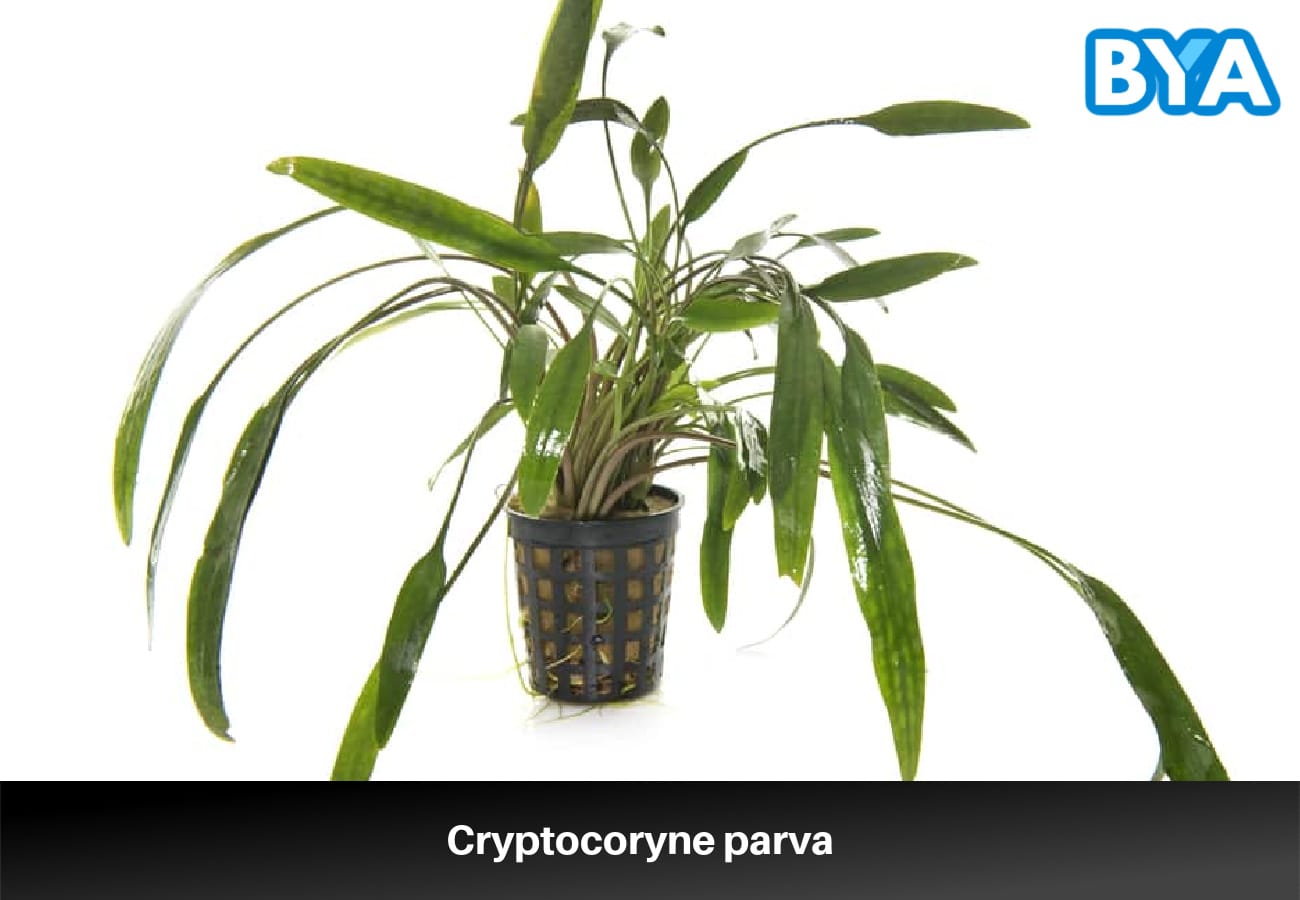
- Lighting: High
- Difficulty: Moderate to Difficult
Cryptocoryne parva is a bit more challenging to care for because it needs high lighting. It doesn’t tolerate shade from larger plants growing above it. It also needs constant access to nutrients.
These plants are popular because they create a carpet across the substrate.
The nice thing about these plants is that they grow slowly and rarely need trimming.
18. Christmas Moss
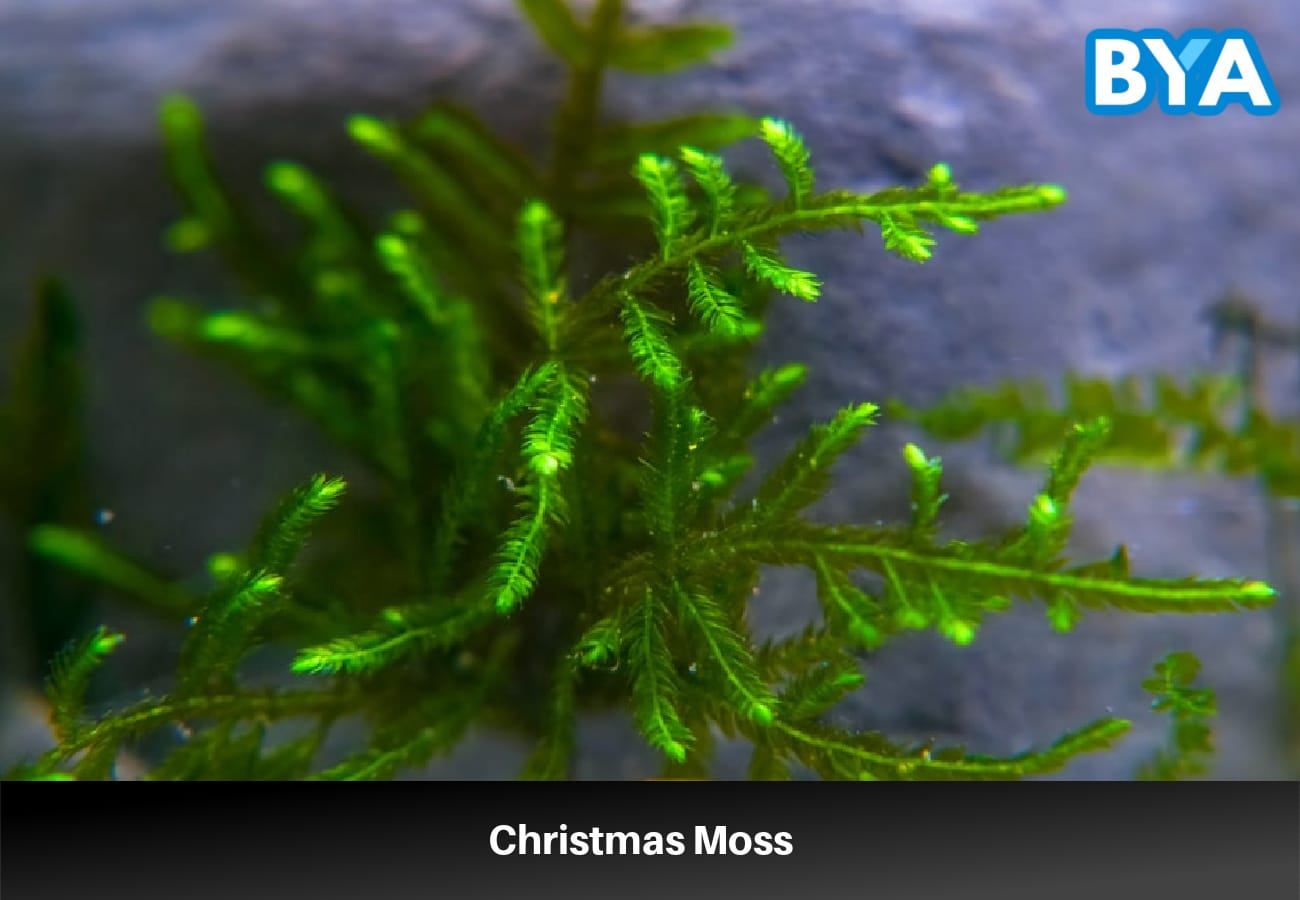
- Lighting: Moderate
- Difficulty: Easy
Christmas moss looks much like java moss, though it grows more slowly.
Unlike java moss, Christmas moss does not attach itself to everything. It is not likely to overtake a tank.
Instead, it keeps to itself in tiny clumps resembling fir trees, where it got its name. Aquarists that buy many of these moss clumps can make their aquarium look like a little forest.
Christmas moss is hardy and grows best in moderate lighting. It does well in warmer water between 78-80°F (25.6-26.7°C).
19. Marsilea Minuta
- Lighting: High
- Difficulty: Moderate
Marsilea minuta is a carpeting plant that looks like a clover. It grows slowly and does well in a broad range of water temperatures.
These plants are moderately difficult to care for. They need high light and a substrate with some nutrients.
Low-light conditions will not kill the plant, though it will not form a carpet. Instead, it grows taller, attempting to reach the light.
20. Pygmy Chain Sword Plant
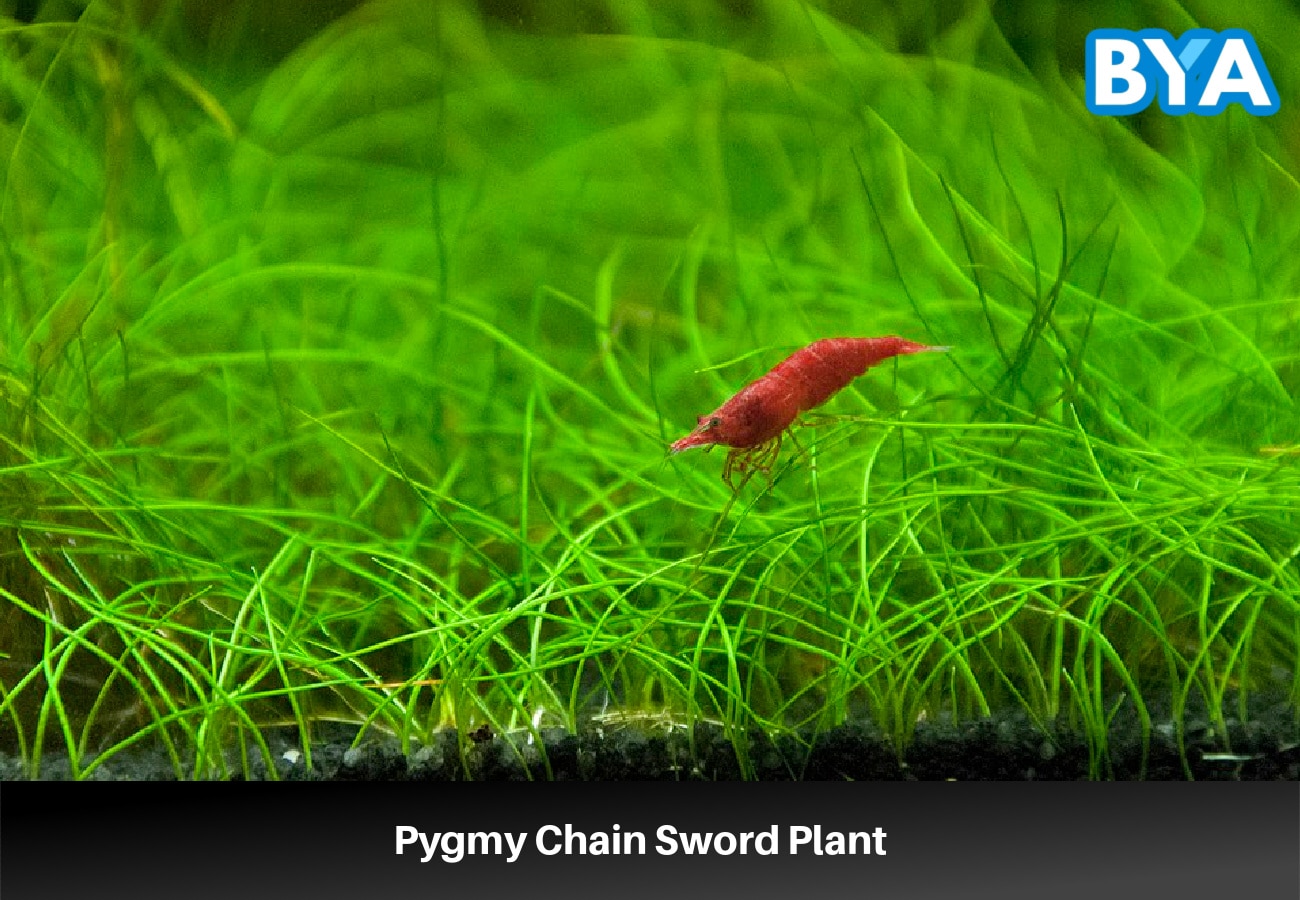
- Uccio D’Agostino / CC BY
- Lighting: High
- Difficulty: Moderate
These plants are suitable for those that like the look of Amazon swords but don’t have room for them.
Pygmy chain swords grow from rhizomes, creating a long chain of leaves. A single plant will continue growing.
Eventually, it creates a large carpet of leaves across the substrate. The result is an aquarium that looks like it’s covered in grass.
Pygmy chain swords need some extra care. They prefer high lighting and a substrate with lots of nutrients. Still, they are tolerant of a wide range of pH and temperatures.
21. Cryptocoryne Wendtii
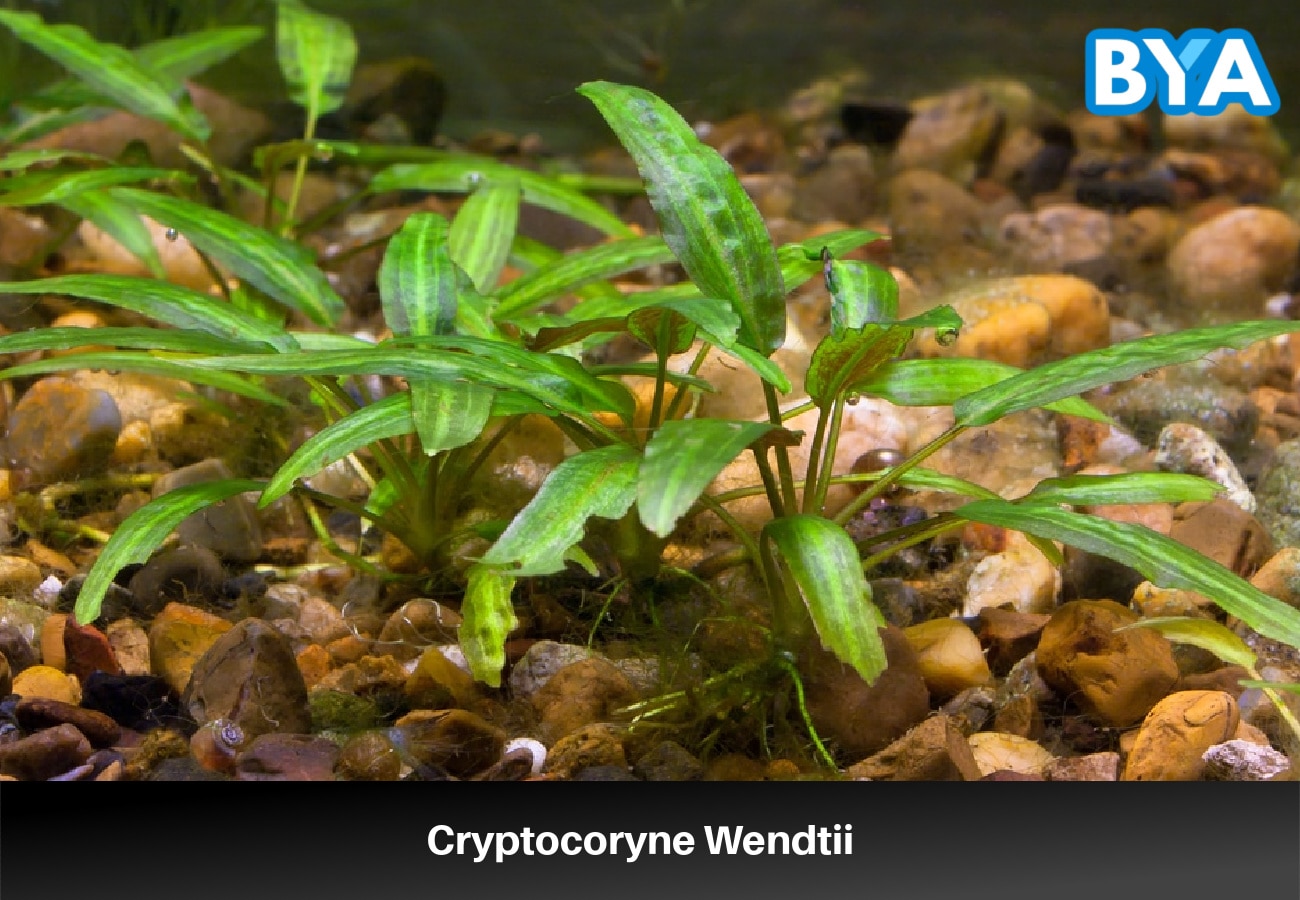
- Size: 6-8 in (15.2-20.3 cm)
- Lighting: Low to Moderate
- Difficulty: Easy
These plants are one of the best for beginning aquarists. They’re hardy and thrive in low light. They naturally inhabit the waters of Sri Lanka. They grow in the shade of overhanging trees and larger plants.
Avoid keeping cryptocoryne wendtii in a high-light tank. The extra light will harm and eventually kill the plant.
Cryptocoryne wendtii gets most of its nutrients from the substrate. They enjoy fertilizers like root tabs.
These plants are great for bettas. They are slow-growing, small, and prefer slow-moving water.
They can add some color to any tank because they come in colors varying from dark green to reddish brown.
22. Vallisneria
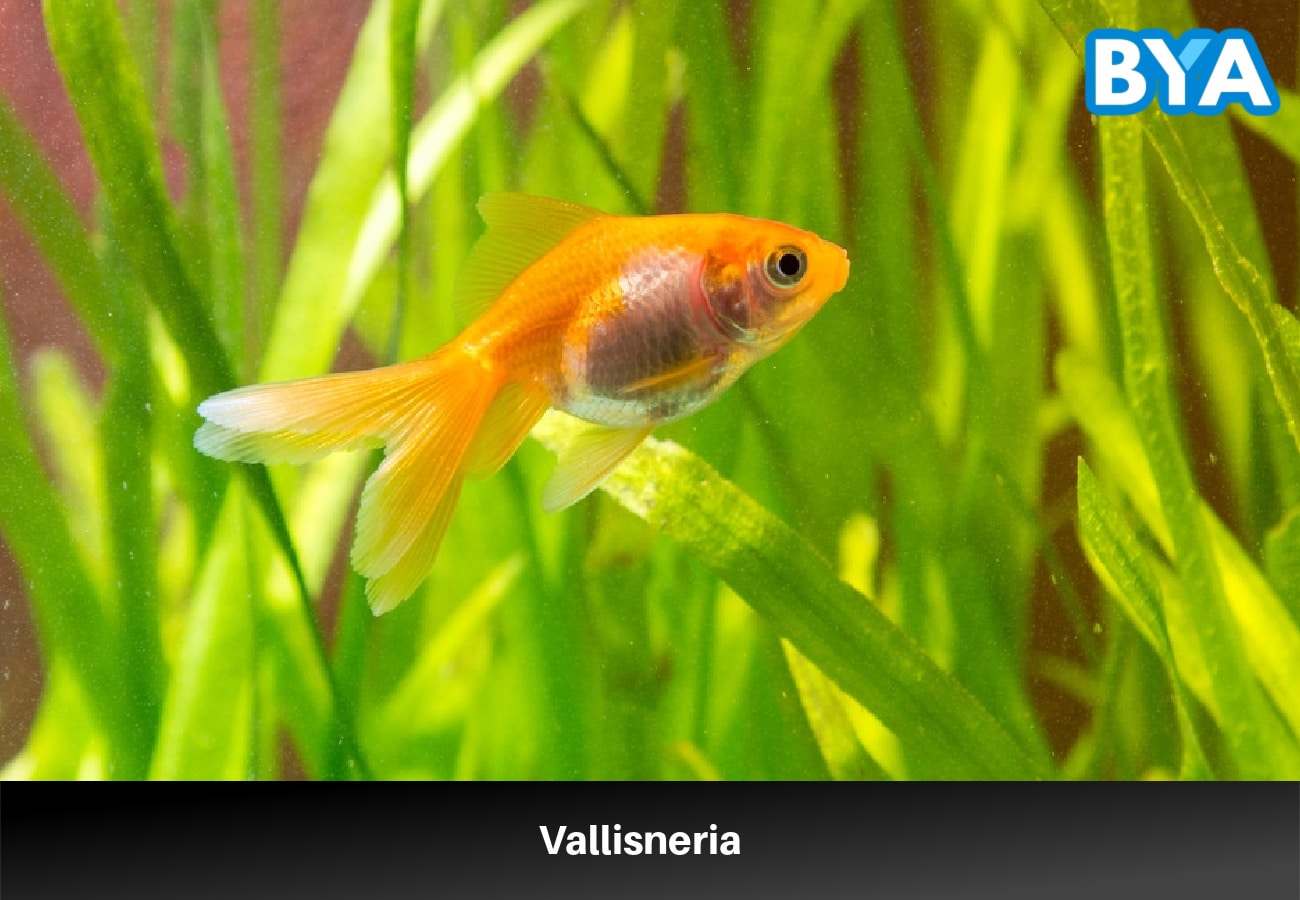
- Lighting: Low to High
- Difficulty: Easy
Vallisneria looks like eelgrass, giving aquariums a natural, aquatic feel.
These plants are effortless to care for. They do well as long as they get some light and plenty of nutrients. They are easy to prune and make a good backdrop for any tank.
There are several species of Vallisneria. The two most popular are V. spiralis and V. gigantea.
V. spiralis has twisting leaves that give it a unique look. V. gigantea grows tall, making it a great background plant that covers tubes and filters.
FAQ
Can You Use Fake Plants For Bettas?
It’s okay to use fake plants instead of live ones. Aquarists should be careful about which ones they choose; not all fake plants are suitable.
Opt for soft silk plants. They look more natural and are gentle on delicate fins and scales. Bettas can still rest on the leaves and hide in the plants without injuring themselves.
Avoid hard plastic plants at all costs. They aren’t suitable for any fish and are particularly bad for bettas. A betta’s long, flowy fins are delicate and easily damaged by the sharp edges of plastic plants.
Not everyone has a green thumb; not wanting to work with live plants is understandable.
Still, we recommend choosing some super easy plants rather than fake ones. Anubias sp., cryptocoryne wendtii, and hornwort are all super easy to care for.
Live plants help keep the aquarium cleaner and give it a more natural look.
What Are Betta Hammocks?
A betta hammock is a product sold in most pet stores. It is a fake, single leaf that attaches to the side of the tank with a suction cup.
These products are great for providing a resting spot for bettas.
Still, hobbyists can add real plants to their tanks that can act as the same thing.
Can You Keep A Betta In A Bowl?
Owners should never keep their betta in a bowl. (There are tanks like the Penn-Plax Aquarsphere or BiOrb that are exceptions). These bowl-shaped aquariums come with a light and a filter built in, and it’s easy to install a heater.
These tanks aren’t what hobbyists usually think of when thinking of a betta bowl, though.
Inexperienced owners usually place bettas in a small, unheated, unfiltered bowl. These bowls usually offer less than two gallons of space.
It’s a common myth that bettas don’t need special care and can live in a small bowl. Sure, they will live for a short time. Still, they won’t live as long as possible and won’t be happy.
Bettas need at least five gallons of space to explore. They need a heater to warm their water and a filter to keep their tank clean.
Will Bettas Eat Plants?
Bettas are obligate carnivores, like cats, meaning they must eat meat. Their bodies cannot digest plant material; they won’t eat plants.
If they’re curious, bettas may nip at a plant, though they won’t eat it.
